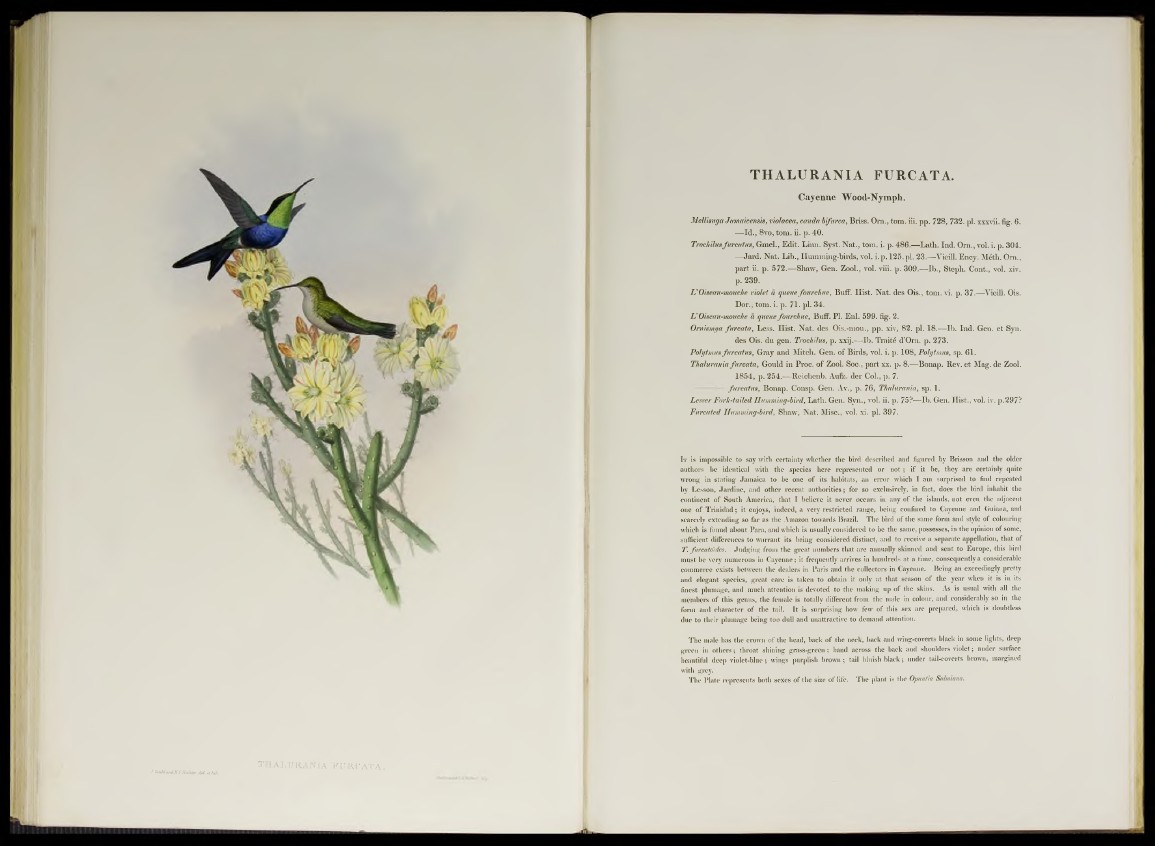
J. Goid&ojx&lF. C TfacJtfcr, Höb. tl litli
t h a l u r a b t a f u r c a t a .
THALURANIA FURCATA.
Cayenne Wood-Nymph.
Mellimga Jamaicensis, violacea, cauda bifurca, Briss. Om., tom. iii. pp. 728, 732. pl. xxxvii. fig. 6.
—Id., 8vo, tom. ii. p. 40.
Trochilusfurcatus, Gmel., Edit. Linn. Syst. Nat., tom. i. p. 486.—Lath. Ind. Om., vol. i. p. 304.
—Jard. Nat. Lib., Humming-birds, vol. i.p. 125.pl. 23.—Vieill. Ency. Métb. Om.,
part ii. p. 572.—Shaw, Gen. Zool., vol. viii. p. 309.—Ib., Stepb. Cont., vol. xiv.
p. 239.
UOiseau-mouche violet a queue fourchue, Buff. Hist. Nat. des Ois., tom. vi. p. 37S-Vieill. Ois.
Dor., tom. i. p. 71. pl. 34.
H Oiseau-mouche a queue fourchue, Buff. Pl. Enl. 599. fig. 2.
Omismya furcata, Less. Hist. Nat. des Ois.-mou., pp. xiv, 82. pl. 18.—Ib. Ind. Gen. et Syn.
des Ois. du gen. Trochilus, p. xxij.— Ib. Traité d’Orn. p. 273.
Polytmus furcatus, Gray and Mitch. Gen. of Birds, vol. i. p. 108, Polytmus, sp. 61.
Thalurania furcata, Gould in Proc. of Zool. Soc., part xx. p. 8 .—Bonap. Rev. et Mag. de Zool.
1854, p. 254.^—Reichenb. Aufz. der Col., p. 7.
— furcatus, Bonap. Consp. Gen. Av., p. 76, Thalurania, sp. 1.
Lessei' ForJc-tailed Humming-bird, Lath. Gen. Syn., vol. ii. p. 75?—Ib. Gen. Hist., vol. iv. p.297?
Furcated Humming-bird, Shaw, Nat. Misc., vol. xi. pl. 397.
It is impossible to say witli certainty whether the bird described and figured by Brisson and the older
authors be identical with the species here represented or n o t; if it be, they are certainly quite
wrong in stating Jamaica to be one of its habitats, an error which I am surprised to find repeated
by Lesson, Jardine, and other recent authorities; for so exclusively, in fact, does the bird inhabit the
continent of South America, that I believe it never occurs in any of the islands, not even the adjacent
one of Trinidad; it enjoys, indeed, a very restricted range, being confined to Cayenne and Guiana, and
scarcely extending so far as the Amazon towards Brazil. The bird of the same form and style of colouring
which is found about Para, and which is usually considered to be the same, possesses, in the opinion of some,
sufficiënt differences to warrant its being considered distinct, and to receive a separate appellation, that of
T. fiircatdides. Judging from the great numbers that are annually skinned and sent to Europe, tbis bird
must be very numerous in Cayenne; it frequently arrivés in hundreds at a time, consequently a considerable
commerce exists between the dealers in Paris and the collectors in Cayenne. Being an exceedingly pretty
and elegant species, great care is taken to obtain it only at that season of the year when it is in its
finest plumage, and much attention is devoted to the making up of the skins. As is usual with all the
members of this genus, the female is totally different from the male in colour, and considerably so in the
form and character of the tail. It is surprising how few of this sex are prepared, which is doubtless
due to their plumage being too dull and unattractive to demand attention.
The male has the crown of the head, back of the neck, back and wing-coverts black in some lights, deep
green in others; throat shining grass-green ; band across the back and shoulders violet; under surface
beautiful deep violet-blue; wings purplish brown ; tail bluish black; under tail-coverts brown, margined
with grey.
The Plate represents both sexes of the size of life. The plant is the Opuntia Salmiana.